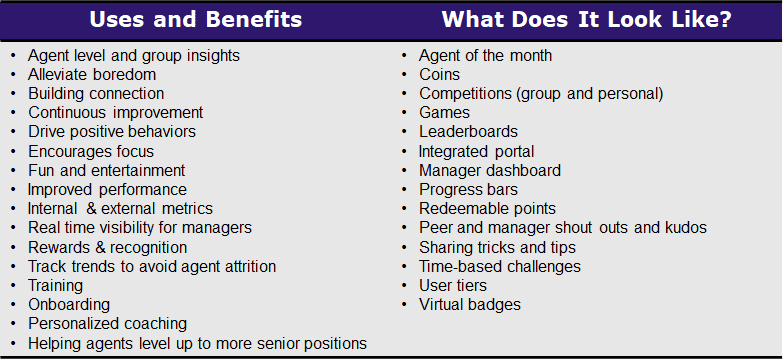Gamification is a tool that is being used across many industries to increase engagement, collaboration, and productivity. In the contact center it has been used successfully either as part of a larger platform or as a standalone feature.
Dash Research recently interviewed two providers in the contact center space, global cloud leader in experience orchestration Genesys, as well as contact center-focused real time guidance, coaching and quality assurance (QA) provider Balto to learn more about uses and best practices when deploying gamification in the contact center.
Uses and Benefits
Gamification has wide ranging benefits and uses, and we delved into several specific areas including training, recognition, real-time data, and community building.

Marc Bernstein, Founder and CEO of Balto, says, “A lot of tools being used in a contact center are not agent focused. Sometimes call centers can be very transaction centered, viewing calls as an exchange between companies and customers, but what about the agent? Yes, they may have solved a complaint, but are they happy? From our perspective, contact centers have to view tools from an agent-first lens to make their usage most effective.”
“How companies have been using gamification can be very different. Some lean into it pretty deeply, as a way to celebrate successes and motivate employees. Others are using it as a basic scorecard, while others are use it for data to apply performance improvement type processes and remediations,” says Cameron Smith, VP of Product Management for WEM, Genesys
Training & Coaching: “Gamification is one tool to complete the circle of managing and supporting people,” says Genesys’ Smith. “When people join a call center, there is onboarding, training, and a fast period where they have to get their knowledge base up so agents can provide quality interactions. Gamification is something that sits on the side and can be used to not just track and support individuals, but also teams and groups.”
Harnessing the data coming in through gamification can help employees get better targeted training materials and coaching and can also help support better customer experience by smoothing out some of the rough edges in agent-customer interactions.
Says Smith, “The data and metrics coming in helps with harder targets such as productivity, but other softer areas such as using text and sentiment analysis to see if agents are showing empathy and expressing the quality the organization wants to apply.”
“It is important to not just show performance, but to give the agents what they need to improve so that they can reach their goals,” says Smith. “When contact centers get busy, often coaching doesn’t get done. Genesys can tie worldwide data showing busy weeks often equate to less training. But if that happens week to week, that means less coaching for agents, and often customer sentiment goes down. Agents start to have less than optimal conversations with customers. With this real time data coming in, we can see this happening on a dashboard and suggest to agents ways to reset and take a pause as they continue throughout their day. Maybe it’s using the technology of our partner Thrive or maybe it’s engaging with a certain training type,” shares Smith.
According to Balto, tying competitions to specific training has benefits. If agents get a heads-up on a competition that will occur after a training session is done, they will be much more likely to both attend to training materials more closely and approach their calls enthusiastically.
Recognition: Recognition can take many forms. Balto has seen it come in the form of public shout-outs, a virtual badge, or an agent of the month program. Agents can be encouraged to recognize peer successes by earning points for doing so. Gamification also provides managers with a way to award and incentivize win marks to keep motivation high.
“We have also seen the use of gift cards when challenges have been won as well as a little bit of action around paid time off (PTO) and different employee privileges,” says Bernstein.
Providing boosts to agents can provide some moments of delight in a role that can pinball between monotony and adrenaline-filled hours of busyness. The Balto system has confetti that bursts onto the screen agents as agents complete their Smart Checklist items. This helps to both celebrate success and reinforce positive behavior. Balto has awarded 30,247 Collection badges and 1,339 Challenge badges.

Manager Dashboards & Real-Time Insights: Manager dashboards allow leaders to view how close or far away agents are from their goals. This can be highly individualized and based on job, tenure, and experience.
“For managers, it really helps to see what the metrics are, but more importantly to see it against the goals agents and managers have set. It can allow managers to see performance and make recommendations for training, coaching, or just a one-on-one interaction. With the Genesys offering, this can all be done from a single pane of glass,” says Smith. “In the legacy models, some employees were only getting performance updates once a month. What we are hearing from customers is that getting updates as they go, that real time visibility has been very helpful. And from an employee point of view, historically they have been asked to perform, but they don’t know how they are performing. This helps to solve that.”

Carestream Dental is using Genesys Cloud CX as its platform and has also used gamification for leveraging real-time metrics. “Every quarter, we’d disseminate multiple reports, review performance data, and provide employees with feedback,” says Brian Harris, Director, Client Services & Support Center. “That wasn’t helpful to the individual or the company because it meant both were potentially carrying bad habits and practices for three months. Now agents can quickly see how they rank within their team on any measure. And they can understand which behaviors they should change to maximize their performance and achieve rewards and incentives.” After implementing the Genesys product, the company saw 15% better response time, a 10% improvement in schedule adherence, and a record NPS rating which was six points higher than the previous year.
Connection & Community: The use of gamification can spark a competitive but collaborative spirit amongst agents, fostering a deeper sense of connection and community. This has been particularly important with many contact centers shifting to hybrid or at home models with many employees not having the opportunity to meet each other.
Says Bernstein, “Balto tries to make it very socially driven, which has been important with some contact centers being hybrid. This is a tool that can be used to boost community and engagement no matter where your agents are located.”
Smith adds, “This link to connection is interesting and growing. COVID really highlighted that you have to support and care for your employees. If you don’t, they won’t perform well, but more importantly, they won’t be engaged or satisfied with their jobs and will likely leave.”
Best Practices
Both executives admit that some contact centers use gamification in a way that might be construed as punitive. Companies using that strategy usually do not end up with great results, and struggle to get traction with agent engagement.
According to Bernstein, “There is thoughtful gamification and there is also trashy gamification. Balto believes its most successful when it is used to gently guide and encourage positive agent behaviors.”
Says Smith, “Those who champion gamification as Genesys customers use it as an engagement tool, as a rewards and recognition tool, as an ability for the organization to say…hey, this person is awesome. Excellent job, let’s celebrate it. But it definitely takes a certain type of culture to utilize the tool in this way. Some avoid it as they view it as shifting the culture towards something they are not comfortable with.”
“Gamification allows companies to take a softer approach to productivity. It lets them be more caring and celebrate successes, knowing the productivity piece will come,” says Smith.
Having gamification layered into what agents are interacting with on a daily basis helps to drive engagement and increases benefits. Both companies Dash spoke with have gamification bundled into their core offering.
Says Smith, “Genesys uses it as a centralized landing spot for employees and we have very high engagement. We currently have 300,000 agents using it with 2.2 million views a day. Agents simply see it as part of their day to day, rather than a gamification technology. It really is core to what we have built across our Workforce Engagement Management (WEM) solution, and we have new features coming up that will get people even more motivated to use it.”
Gamification can be kept fresh by offering time-based team and personal challenges. “When Balto launches a new customer, we try to get them going on these time-based challenges immediately,” says Bernstein. “It’s a way to keep engagement ongoing and interesting.”
Moving the Market Forward
The Genesys path to offering gamification came through acquisition, and usage has quickly grown. Genesys acquired Silver Lining Solutions, a provider of performance management, assessment, learning and coaching solutions in 2017. Genesys thought it would build gamification on top of it. However, a company named nGuvu, which was in the Genesys Foundry, had a strong gamification offering and was acquired by Genesys in March 2020. That year, there were 16 customers using it. It was made natively available on Genesys Cloud in January 2021 and there are currently 800 customers using the tool.
“We are really proud of our achievements in this area. nGuvu’s gamification offering was priced at $20 per seat and it was just a bridge too far for most contact centers. We wanted it to be an integral part of our WEM story and were able to build in a way that we didn’t need to charge extra for it,” says Smith.
Balto launched its gamification offering in September 2022, and was part of a set of features aimed at improving agent experience. “Many of the verticals we focus on have a high customer lifetime value and we feel there is often a mismatch between how people are recruited, trained, and retained and the value these agents are bringing to an organization. Agent experience must be kept top of mind,” says Bernstein. Balto has already scored 59.5 million calls on the gamification platform.
Both companies described the path to offering gamification as more of a push into the market than pull, and relish the opportunity to help advance contact center culture.
“When we looked at statistics on attrition and satisfaction, Balto believed if you build it, they will come. We didn’t hear people saying they wanted gamification, but what we did hear was they wanted to drive better behaviors, increase retention, and have a more competitive, but yet collaborative environment. Gamification can really help switch up a culture in a positive way” says Bernstein.
“Some companies still just want agents to focus on their calls and they run a bit of a command-and-control type of atmosphere in contact centers where they just want agents to get through their calls, But the data gathered at Genesys shows the attrition problem. Thirty to forty percent turnover is normal and we have seen even worse. We are very transparent with this data,” says Smith. Genesys is starting to see more of a movement and the company is working to educate the market around the benefits of positive agent experience.
“It’s a bit of a greenfield,” says Smith. “Some companies have very limited understanding and exposure. Some mistakenly believe it’s too technical. We have been using a lot of our community events to try to showcase the benefits and have customers that are using it share experiences and best practices. There is definitely some coaching that is often needed.”
From a Dash Research view, it was great to see the perspective of providing contact center technology that was not laser-focused simply on productivity and cost savings (although gamification can improve both those areas), but as a tool to really shift culture in an industry that often struggles with how to support its workers. The labor market is still tight, especially in front-line types of positions, and companies will need to focus on the state of the employee experience within their organization or risk continued battles with low engagement and agent attrition.
Author Information
As a detail-oriented researcher, Sherril is expert at discovering, gathering and compiling industry and market data to create clear, actionable market and competitive intelligence. With deep experience in market analysis and segmentation she is a consummate collaborator with strong communication skills adept at supporting and forming relationships with cross-functional teams in all levels of organizations.
She brings more than 20 years of experience in technology research and marketing; prior to her current role, she was a Research Analyst at Omdia, authoring market and ecosystem reports on Artificial Intelligence, Robotics, and User Interface technologies. Sherril was previously Manager of Market Research at Intrado Life and Safety, providing competitive analysis and intelligence, business development support, and analyst relations.
Sherril holds a Master of Business Administration in Marketing from University of Colorado, Boulder and a Bachelor of Arts in Psychology from Rutgers University.









